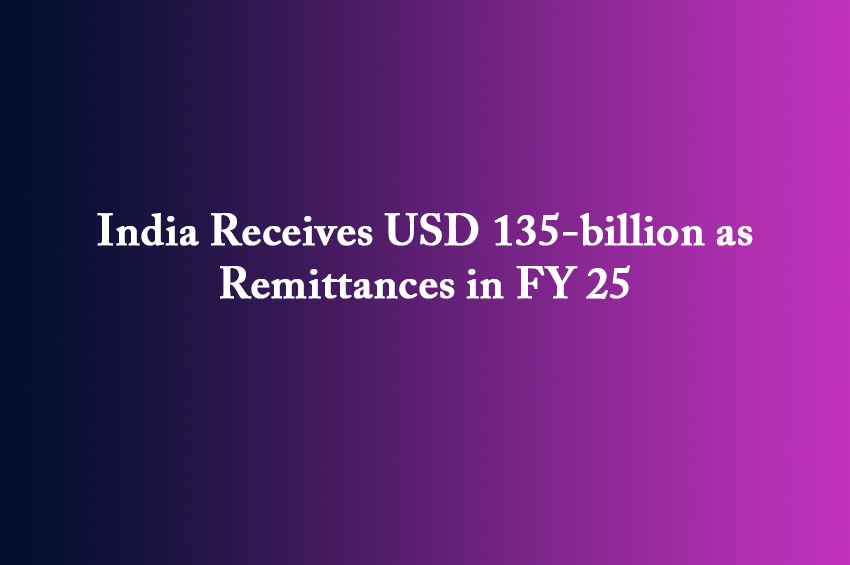Winning Bizness Economic Desk
India Receives USD 135-billion as Remittances in FY 25
The country has received USD 135.46-billion in remittances for the financial year ending March 31, 2025. This figure is the highest on record, according to data shown by the Reserve Bank of India (RBI).
The point to highlight here is that this is a 14 per cent increase from the previous year.
It is important to note that remittances continue to be a major driver of India’s current account flows.
The Reserve Bank of India, the country’s apex bank, said the inflows classified under “private transfers” accounted for more than ten per cent of India’s gross current account flows of USD 1-trillion in FY 25.
What is significant here is that the country has remained the world’s top recipient of remittances since 2016-17, when they totalled USD 61-billion.
India’s Forex Reserves Dip by USD 1.02-bn to USD 697.93-bn
The country’s foreign exchange reserves registered a slight southward movement of USD 1.02-billion to USD 697.93-billion for the week ending June 20, the Reserve Bank of India (RBI) data showed.
This slight slide follows a noteworthy gain of USD 2.294-billion in the previous week. At that time, the reserves had totalled USD 698.95-billion.
The decline was mainly because of an USD 360-million drop in foreign currency assets (FCAs), which had stood at USD 589.07-billion and a slight fall in gold reserves by USD 5.73-billion, bringing the total to USD 85.74-billion.
Here, it must be pointed out that additionally Special Drawing Rights (SDRs) dipped by USD 85-million, settling at USD 18.67-billion. Despite this, the country’s forex reserves position remains very healthy.
The Reserve Bank Governor Mr Sanjay Malhotra recently pointed out that the country’s reserves were adequate to cover 11-months of imports and about 96 per cent of external debt.
Underscoring the resilience of India’s external sector, Mr Malhotra said that the vulnerability indicators continued to improve.
Significantly, the share of gold in the Reserve Bank’s foreign exchange reserves has nearly doubled since 2021. This is in line with the global trend of central banks increasing gold holdings as a safe haven asset.
In 2023, India added USD 58-billion to its forex reserves following an USD 71-billion drawdown in the previous year (2022).
In 2024, the reserves have increased by over USD 20-billion.
India’s forex reserves, comprising foreign currencies, gold, SDRs and IMF reserve positions essay a crucial role in stabilising the country’s currency—the Rupee—and managing external shocks, with the US Dollar making up the largest share of assets.
Kharif Crops: Total Sown Area Crosses 262.15-lakh hectares
The area under the on-going kharif crop sowing has moved northward to 262.15-lakh-hectares so far this year. This is an 11.3 per cent jump as compared to 235.44-lakh hectares in the same period last year (2024).
The above is as per the data released by the Ministry of Agriculture and Farmer Welfare.
An increase of 26.71-lakh hectares in the sown area in the early part of the season augurs well for higher production. The point to note here is that higher production has the potential to increase the incomes of farmers and also help to rein-in food inflation.
Official figures reveal that the area under rice is 35.02-lakh hectares as on June 27 this year, as compared to 23.78-lakh hectares during the same period last year.
The area under pulses such as urad and moong has been reported at 21.09-lakh hectares as compared to 15.37-lakh hectares in the year-ago period last year.
What needs highlighting here is that an increase of 5.37-lakh hectares in the early part of the season is a good beginning, as any increase in the production of pulses plays a key role in reining-in inflation.
The area covered under coarse cereals or millets such as jowar, bajra and ragi has zoomed up to 41.75-lakh hectares during the current season so far from the 35.01-lakh hectares in the same period of the previous year.
An important point to note here is that the sown area has risen in the current season as better monsoon rains have facilitated sowing in the unirrigated areas of the country, which accounts for close to 50 per cent of the country’s farmland.
The area under sugarcane has also increased to 55.16-lakh hectares from 54.88-lakh hectares in the same period of the previous year.
The Cabinet Committee on Economic Affairs, chaired by Prime Minister Mr Narendra Modi on May 28 of this year, approved an increase in the Minimum Support Price (MSP) for 14 kharif crops for the marketing season 2025-26 to ensure remunerative prices to the growers for their crops and incentivise production.
India’s June Palm Oil Imports Zooms 61 pc to Hit 11-Month High
The country’s palm oil imports have climbed-up steeply to an 11-month high in June of this year. This jump in imports has been primarily propelled by lower domestic inventories and a price discount to rival soy oil and sunflower oil that drove refiners to considerably increase their purchases.
An important point to note here is that India is the biggest buyer of vegetable oils in the world.
Higher palm oil imports by India, therefore, will help reduce stocks with the top producers such as Indonesia and Malaysia and support benchmark Malaysian palm oil futures.
Palm oil imports in June zoomed 61 per cent Month-on-Month (MoM) to 9,53,000-metric tonnes, the highest since July 2024, according to a leading news publication citing estimates from dealers.
The country imported on an average 4,75,699-tonnes of palm oil each month during the first seven-months of the current marketing year ending October 2025, according to the Solvent Extractors’ Association of India (SEAI).
In the last marketing year, India imported an average of more than 7,50,000-tonnes of palm oil each month.
Soy oil imports in June slid southward nine per cent MoM to 3,67,000-tonnes, while sunflower oil imports increased 18 per cent to 2,16,000-tonnes.
Higher imports of palm oil and sunflower oil lifted the country’s total edible oil imports in June by 30 per cent from the month before to 1.53-million tonnes, the highest since November, according to dealers’ estimates as reported by the leading news publication.
An important point to note here is that palm oil imports are expected to remain high in the coming months as its prices are attractive amid a pick-up in production in key producing countries.
India purchases palm oil mainly from the south-east Asian nations of Indonesia and Malaysia while it imports soy oil and sunflower oil from Argentina, Brazil, Russia and Ukraine.
Housing Sales Slide Southward 20 pc in India and 25 pc in MMR
Housing sales in major centres of the country have been adversely affected with sales steeply sliding by 20 per cent in the seven metropolitan cities of the country.
This decline is primarily because of increasing property prices and geo-political tensions and this 20 per cent sales-drop is in the second-quarter (Q2) of 2025 as compared to Q2 of the previous year (2024).
The Mumbai Metropolitan Region (MMR) was the hardest hit with housing sales declining by 25 per cent from 41,540 units in Q2 2024 to 31,725 units in Q2 2025, according to a report by the real estate consulting firm Anarock.
Around 96,285 houses were sold in the April-to-June period or Q2 2025 across the seven metropolitan cities—the National Capital Region, MMR, Bangalore, Pune, Hyderabad, Chennai and Kolkata as compared to 1,20,335 houses sold in the same period in 2024.
The report stated that housing sales in the seven cities increased marginally by three per cent as compared to Q1 of 2025. The southern state of Chennai registered a sharp sales spike of 40 per cent, while the NCR, Hyderabad and Bangalore, clocked a rise of 14 per cent, nine per cent and one per cent, respectively.
“The second-quarter of 2025 was a roller-coaster for the Indian housing market raked by major military actions at home and abroad. The warlike climate pushed home-buyers into wait and watch mode, compounding the impact of soaring property prices over the past two-years,” the Anarock Group’s Chairman Mr Anuj Puri was quoted as saying in a leading news publication.
“Now, with domestic tensions easing and the Reserve Bank of India’s repo rate cut injecting fresh optimism, buyer sentiment is rebounding,” Mr Puri added.


